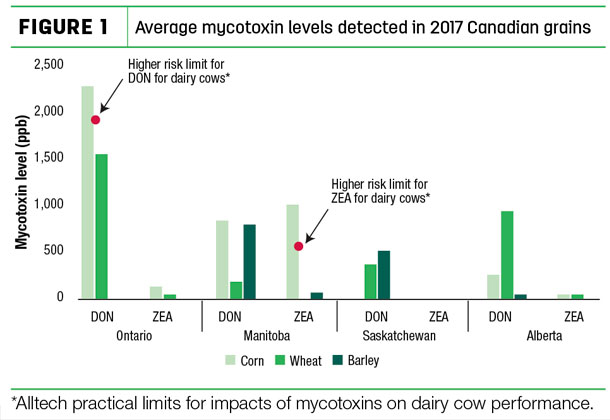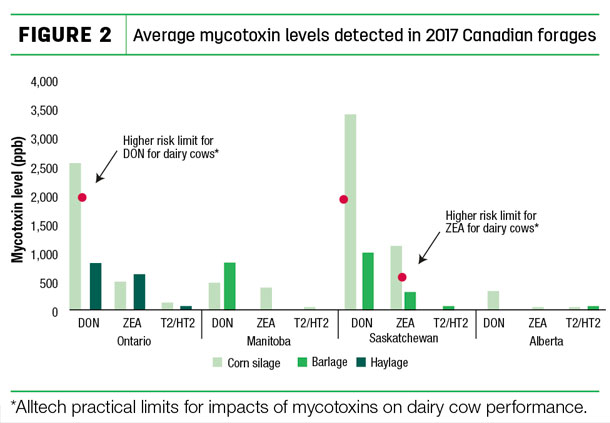The occurrence and concentration of mycotoxins is influenced by many factors, including drought, excess rainfall, hot or cool temperatures, pests and agronomic practices.
Although mycotoxins were first identified more than 50 years ago, they are gaining more attention due to changing agricultural practices, improved analytical technology, new scientific research and varying climate conditions.
They are seldom found in isolation and, when multiple mycotoxins are consumed, they may have additive, or even synergistic, interactions that increase the overall risk to performance and health.
As a result, a cow may have a stronger response than what would be expected if it was only experiencing a single mycotoxin challenge.
2017 Canadian mycotoxin harvest analysis
The 2017 growing season was a variable and challenging one across Canada. The prairies experienced very dry growing conditions and above-normal temperatures.
At the same time, Ontario received above-average rainfall across most of the province, and many growers were delayed in getting their crop in the ground. In both scenarios, these weather conditions not only reduce yield but can also increase plant stress and lead to challenges with insects or moulds.
In the fall of 2017, some areas saw late-season rains or early frost and snow, which further increased plant stress and delayed harvest. These weather events could increase the potential for mould growth and mycotoxin production, and are likely to increase the risk for multiple mycotoxin contamination.
Mycotoxins in Canadian grains
Results from samples submitted by Alltech to Stratford Agri Analysis, based in Stratford, Ontario, show grains from across Canada are at risk of mycotoxin contamination.
These samples submitted for analysis between Sept. 1 and Oct. 15 showed grains contained mixtures of mycotoxins, including deoxynivalenol (DON) and zearalenone (ZEA) (Figure 1).

Although all grains contained some level of mycotoxins, corn and wheat from Ontario and corn from Manitoba appear to be the grains with the highest levels of DON and ZEA.
As a result of the late-season rains in many provinces, especially following the dry conditions during summer in the prairies, there is additional potential for mycotoxins such as fumonisins.
The production of fumonisins often proliferates under these conditions, as the producing mould prefers low moisture and warm weather when the plant is flowering, followed by rain at harvest.
Mycotoxins in Canadian forages
Forages such as corn silage, barlage and haylage appear to have contained multiple mycotoxins in 2017, particularly from mycotoxins produced by Fusarium species of moulds.
The samples analyzed for mycotoxins by the Stratford Agri Analysis laboratory between Sept. 1 and Oct. 15 showed DON, ZEA and T-2/HT-2 toxins are of concern in forages (Figure 2).

The results showed forages from Ontario and Saskatchewan contained the highest levels of mycotoxins, with corn silage having been the commodity of greatest risk in these areas.
Effect of mycotoxins on ruminants
When cows consume feed contaminated with mycotoxins, there can be negative effects that result in long-term declines in performance and, ultimately, lower farm profitability.
Chronic mycotoxin consumption, in which smaller quantities of contaminated feed are consumed over time, is often more challenging than an acute single dose, as the mycotoxin risk may not be noticed until a loss of production and health has already occurred.
Although the rumen micro-organisms can help to degrade some mycotoxins, they may also convert other mycotoxins into more potent forms. Certain mycotoxins can pass through the rumen unchanged to be later absorbed in the small intestine, while other mycotoxins may have antibiotic-like effects directly on the beneficial rumen micro-organisms. As a result, the rumen and gastrointestinal tract are main targets of mycotoxins in cows.
Based on the Fusarium mycotoxins (DON, ZEA and T-2/HT-2 toxins) detected in this year’s grain and forage samples, cows may show a multitude of symptoms such as changes to feeding behaviour, rumen disorders, lesions or haemorrhaging of the gastrointestinal tract, altered conception rates, lower milk production or altered milk components and increased disease occurrence.
Dairy animals may also have poor udder health with increased somatic cell counts or increased incidence of mastitis.
Mycotoxin management on-farm
For the feedstuffs harvested in 2017 and currently being fed, it is important to conduct a mycotoxin analysis that identifies the storage mycotoxins, including Penicillium and Aspergillus mycotoxin groups, as there is added potential for additional mycotoxins to develop during storage.
Storage measures may be taken to help reduce the risk of further development of mould and mycotoxins, such as:
- Properly dry grains to less than 13 percent moisture.
- Improve packing density.
- Ensure proper fermentation has occurred.
- Inspect storage quality to minimize moisture, air, insect or pest entry.
- Conduct mycotoxin analysis at harvest and after storage to identify the appropriate management strategy for those feedstuffs on-farm.
Mycotoxins are a challenge to animal and feed production. Employing preventive measures for managing mycotoxins is essential to minimize profit loss. Proper mycotoxin management techniques can reduce the risk of mycotoxins coming from feed materials as well as help to prevent the negative effects mycotoxins can have on dairy cow performance and health. ![]()
PHOTO: Annual testing of grains and forages reveals the risks of mycotoxins in the recently harvested crop. Photo courtesy of Alltech.
Visit Alltech Mycotoxin Management for more information on mycotoxin management.

-
Alexandra Weaver
- Mycotoxin Management
- Alltech
- Email Alexandra Weaver










